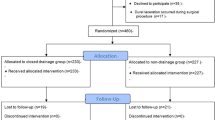Abstract
In this study we aimed to evaluate the role of closed-suction drainage on the extent of epidural fibrosis (EF) after lumbar disc surgery and to define a new grading system of epidural fibrosis in these patients, based on magnetic resonance imaging. Seventy-nine patients (34 women, 45 men) with a unilateral, single-level lumbar disc herniation were included in this study. Forty-one patients in whom closed-suction drainage was implanted were compared with 38 patients in whom the drain was not implanted. We have used a new grading system for the extent of epidural fibrosis, on the basis of follow-up magnetic resonance imaging findings. Pain intensity was evaluated by visual analog scale (VAS), and the patients’ function and working ability were measured according to the Prolo functional-economic scale. We conclude that, in patients operated on for unilateral, single-level lumbar disc hernias, implantation of closed-suction drainage into the operation site results in less formation of EF radiologically and yields better clinical outcome.


Similar content being viewed by others
References
Annertz M, Jonsson B, Stromqvist B, Holtas S (1995) No relationship between epidural fibrosis and sciatica in the lumbar postdiscectomy syndrome. A study with contrast-enhanced magnetic resonance imaging in symptomatic and asymptomatic patients. Spine 20:449–453
Aydin Y, Ziyal IM, Duman H, Turkmen CS, Basak M, Sahin Y (2002) Clinical and radiological results of lumbar microdiscectomy technique with preserving of ligamentum flavum comparing to the standard microdiscectomy technique. Surg Neurol 57:5–14
Cervellini P, Curri D, Volpin L, Bernardi L, Pinna V, Benedetti A (1988) Computed tomography of epidural fibrosis after discectomy: a comparison between symptomatic and asymptomatic patients. Neurosurgery 23:710–713
Colak A, Bavbek M, Aydin NE, Renda N, Acikgoz B (1996) Effect of CO2 laser on spinal epidural fibrosis. Acta Neurochir (Wien) 138:162–166
Coskun E, Suzer T, Topuz O, Zencir M, Pakdemirli E, Tahta K (2000) Relationships between epidural fibrosis, pain, disability and psychological factors after lumbar disc surgery. Eur Spine J 9:218–223
Davis RA (1994) A long-term outcome analysis of 984 surgically treated herniated lumbar discs. J Neurosurg 80:415–421
Dogulu F, Kurt G, Emmez H, Erdem O, Memis L, Baykaner K, Ceviker N (2003) Topical mitomycin C—induced inhibition of postlaminectomy peridural fibrosis in rabbits. J Neurosurg 99 [Suppl 1]:76–79
Ebeling U, Kalbarcyk H, Reulen HJ (1989) Microsurgical reoperation following lumbar disc surgery. Timing, surgical findings and outcome in 92 patients. J Neurosurg 70:397–404
Fritsch EW, Heisel J, Rupp S (1996) The failed back surgery syndrome: Reasons, intraoperative findings, and long-term results: a report of 182 operative treatments. Spine 21:626–633
Gabriel EM, Friedman AH (1996) The failed back surgery syndrome. In: Wilkins RH, Rengachary SS (eds) Neurosurgery. Mc Graw-Hill, New York, pp 3863–3870
Gerszten PC, Moossy JJ, Bahri S, Bahri S, Kalend A, Martinez AJ (1999) Inhibition of peridural fibrosis after laminectomy using low-dose external beam radiation in a rat model. Neurosurgery 44:597–603
He Y, Revel M, Loty B (1995) A quantitative model of post-laminectomy scar formation. Effects of a nonsteroidal anti-inflammatory drug. Spine 20:557–563
Henderson R, Weir B, Davis L, Mielke B, Grace M (1993) Attempted experimental modification of the post-laminectomy membrane by local instillation of recombinant tissue-plasminogen activator gel. Spine 18:1268–1272
Jinkins JR, Osborn AG, Garrett D Jr, Hunt S, Story JL (1993) Spinal nerve enhancement with Gd-DTPA: MR correlation with the postoperative lumbosacral spine. AJNR Am J Neuroradiol 14:383–394
LaRocca H, Macnab I (1974) The laminectomy membrane. Studies in its evolution, characteristics, effects and prophylaxis in dogs. J Bone Joint Surg Br 56:545–550
Liu S, Boutrand JP, Bittoun J, Tadie M (2002) A collagen-based sealant to prevent in vivo reformation of epidural adhesions in an adult rat laminectomy model. J Neurosurg 97 [1 Suppl]: 69–74
Llado A, Sologaistua E, Guimera J, Marin M (1999) Expanded polytetrafluoroethylene membrane for the prevention of peridural fibrosis after spinal surgery: a clinical study. Eur Spine J 8:144–150
Long DM (1991) Failed back surgery syndrome. Neurosurg Clin N Am 2:899–919
Nussbaum CE, McDonald JV, Baggs RB (1990) Use of Vicryl (polyglactin 910) mesh to limit epidural scar formation after laminectomy. Neurosurgery 26:649–654
Pappas CT, Harrington T, Sonntag VK (1992) Outcome analysis in 654 surgically treated lumbar disc herniations. Neurosurgery 30:862–866
Price DD, McGrath PA, Rafii A, Buckingham B (1983) The validation of visual analogue scales as ratio scale measures for chronic and experimental pain. Pain 17:45–56
Ross JS (1991) Magnetic resonance assessment of the postoperative spine. Degenerative disc disease. Radiol Clin North Am 29:793–808
Ross JS, Robertson JT, Frederickson RCA, Petrie JL, Obuchowski N, Modic MT, de Tribolet N (1996) Association between peridural scar and recurrent radicular pain after lumbar discectomy: Magnetic resonance evaluation. Neurosurgery 38:855–863
Selcuklu A, Pasaoglu A, Akdemir H, Kurtsoy A, Patiroglu TE (1993) Urokinase for control of scar formation after laminectomy. Spine 18:165–168
Songer MN, Ghosh L, Spencer DL (1990) Effects of sodium hyaluronate on peridural fibrosis after lumbar laminotomy and discectomy. Spine 15:550–554
Songer MN, Rauschning W, Carson EW, Pandit SM (1995) Analysis of peridural scar formation and its prevention after lumbar laminotomy and discectomy in dogs. Spine 20:571–580
Williams RW (1978) Microlumbar discectomy: a conservative surgical approach to the virgin herniated lumbar disc. Spine 3:175–182
Author information
Authors and Affiliations
Corresponding author
Rights and permissions
About this article
Cite this article
Sen, O., Kizilkilic, O., Aydin, M.V. et al. The role of closed-suction drainage in preventing epidural fibrosis and its correlation with a new grading system of epidural fibrosis on the basis of MRI. Eur Spine J 14, 409–414 (2005). https://doi.org/10.1007/s00586-004-0801-6
Received:
Revised:
Accepted:
Published:
Issue Date:
DOI: https://doi.org/10.1007/s00586-004-0801-6




